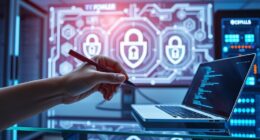To practice good cyber hygiene, use strong, unique passwords for each account and activate two-factor authentication whenever possible. Keep your software and systems updated regularly to fix vulnerabilities. Install trusted threat detection tools and secure your network with proper encryption and configurations. Regularly back up important data and be cautious while browsing—look out for phishing attempts. Monitoring access and data usage helps prevent breaches. Continue exploring these practices to build a safer digital environment.
Key Takeaways
- Use strong, unique passwords and manage them with a password manager; enable multi-factor authentication on critical accounts.
- Keep software, systems, and security tools updated regularly to patch vulnerabilities and improve threat detection.
- Back up data regularly following the 3-2-1 rule, encrypt backups, and test restore procedures for data resilience.
- Implement network segmentation, strong encryption, and disable unnecessary remote management features to enhance network security.
- Promote cybersecurity awareness, avoid suspicious links, verify website security (HTTPS), and manage online extensions carefully.
Use Strong and Unique Passwords for All Accounts

To protect your online accounts, you need to use strong and unique passwords for each one. Aim for at least 12 to 16 characters, as longer passwords are more secure against brute-force attacks. Incorporate a mix of uppercase and lowercase letters, numbers, and symbols, but don’t rely on common words or phrases. Instead, create passphrases using unrelated words or random strings for better memorability and unpredictability. It’s vital to use different passwords for every account to prevent a breach on one from affecting others. Avoid patterns like sequential numbers or repeating habits. To manage multiple passwords effectively, consider using a password manager. Regularly update your passwords and stay vigilant about any breaches to keep your online presence safe. Additionally, understanding mindfulness techniques can help you better manage stress and stay alert to potential security threats. Practicing cyber hygiene regularly can further strengthen your defenses against fraud and data breaches, especially when combined with security awareness training to recognize phishing attempts and other scams.
Enable Two-Factor Authentication Whenever Possible
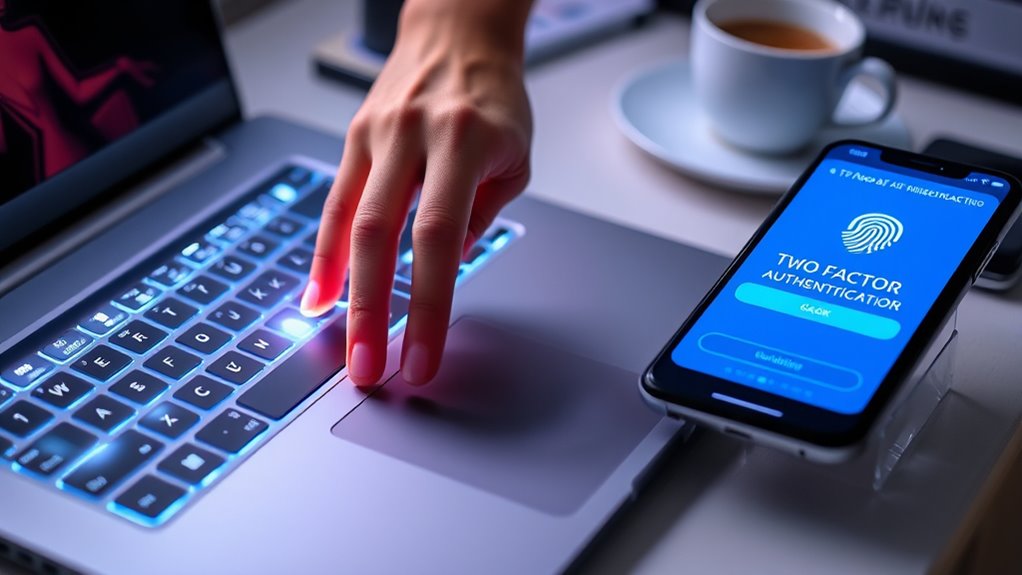
While using strong, unique passwords is a vital step in securing your online accounts, adding a second layer of protection can greatly boost your defenses. Two-factor authentication (2FA) requires two forms of identification—something you know (your password) and something you have or are (like a phone, fingerprint, or security key). It considerably reduces the risk of unauthorized access, even if your password is stolen or guessed. Many platforms now offer 2FA, often through authenticators or hardware tokens, providing better security than SMS codes alone. Enable 2FA on all essential accounts, especially email, banking, and work systems. Regularly review your 2FA settings and backup options to guarantee continuous protection. Incorporating security measures like two-factor authentication into your routine can also enhance daily security awareness by promoting mindful habits. Additionally, integrating AI-powered security tools can help identify suspicious activity more quickly and effectively.
Keep Software and Systems Up to Date Regularly
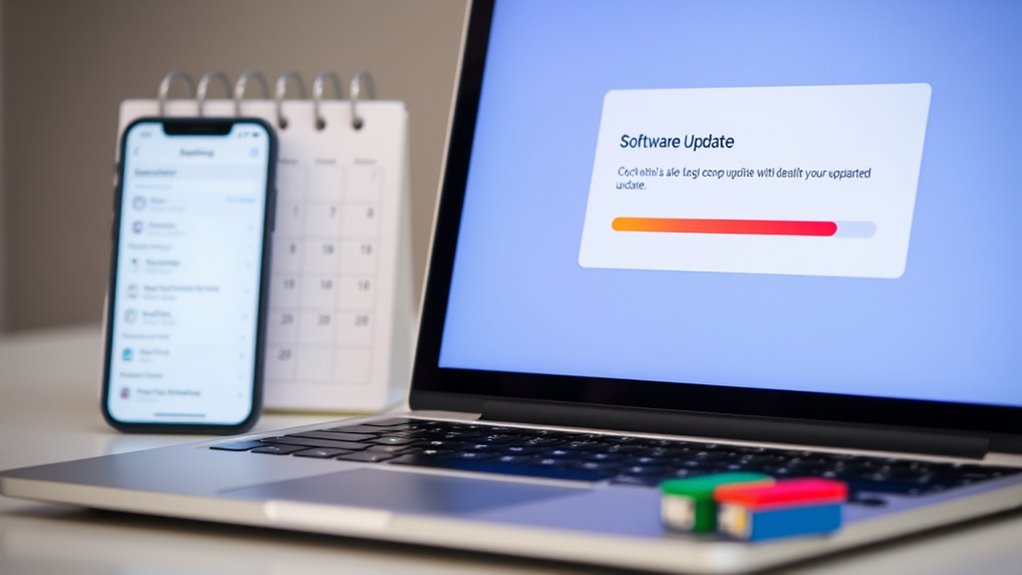
Keeping your software and systems up to date is essential for maintaining security and ideal performance. Regular updates include critical security patches that fix vulnerabilities, reducing your risk of cyberattacks. They also mitigate the exploitation of weaknesses by hackers, helping prevent data breaches and system compromises. Updates improve system performance by fixing bugs and adding new features, including security enhancements that make it harder for attackers to succeed. Failing to update leaves your devices more vulnerable, increasing chances of breaches, crashes, and compatibility issues. To stay protected, enable automatic updates and install patches promptly. Regular updates not only strengthen your defenses but also keep your system running smoothly, reducing overall risks and ensuring your digital environment remains secure. Reviews highlight the importance of choosing well-made, durable devices to support ongoing cybersecurity efforts. Additionally, staying informed about support hours for various entertainment venues can help you plan your visits and avoid disruptions, ensuring a seamless experience.
Install and Maintain Reliable Threat Detection Tools

Installing and maintaining reliable threat detection tools is essential for identifying cyber threats before they cause damage. These tools, like Endpoint Detection and Response (EDR), monitor endpoint activities in real-time, while Network Intrusion Detection Systems (NIDS) analyze traffic for suspicious behavior. Security Information and Event Management (SIEM) systems aggregate logs from various sources, spotting attack patterns. Threat Intelligence Platforms gather data from dark web sources to provide actionable insights, and cloud-based monitors use AI to detect advanced threats across environments. To stay effective, keep your tools updated regularly, ensuring they incorporate the latest threat signatures and AI improvements. Proper integration across endpoints, networks, and cloud platforms enhances visibility, enabling rapid alerts and response, ultimately reducing risks and strengthening your cybersecurity defenses. Regularly reviewing Pimple Patch technology trends can also help in understanding emerging threats and updating defenses accordingly. Additionally, incorporating cyber hygiene best practices helps maintain the integrity of your security systems and prevents vulnerabilities. Maintaining a proactive approach with threat detection tools ensures ongoing protection against evolving cyberattack techniques. Moreover, fostering a culture of security awareness within your organization can significantly improve overall defenses by empowering users to recognize and respond to potential threats.
Secure Your Network With Proper Configurations and Encryption
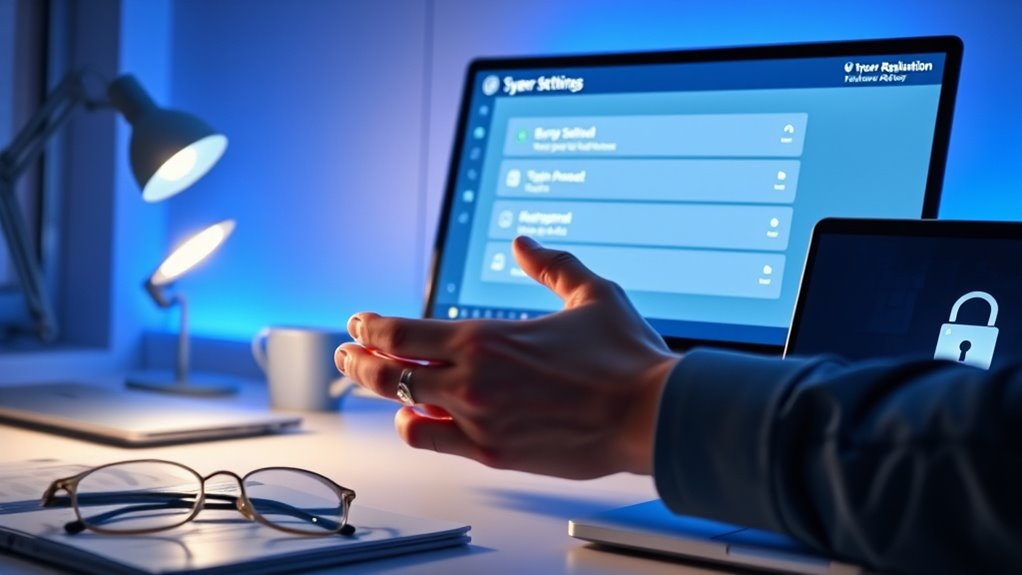
Securing your network starts with implementing proper configurations and strong encryption to defend against unauthorized access and data breaches. Begin by segmenting your network into logical zones or using physical devices like routers, switches, or VLANs to contain potential threats. Create Demilitarized Zones (DMZs) as buffers between internal networks and untrusted external sources. Use strong encryption standards such as WPA3 for wireless networks, with passphrases of at least 20 characters, and ensure wired data is encrypted via VPNs or MACsec. Disable remote management and UPnP to limit exposure, and enforce strong, unique passwords for all devices. Regularly update encryption protocols and keys to stay ahead of cryptographic vulnerabilities. These measures help isolate sensitive systems, making unauthorized access much more difficult. Additionally, maintaining network segmentation reduces the risk of widespread breaches by limiting the spread of intrusions within your infrastructure.
Regularly Back Up Important Data and Use Encryption
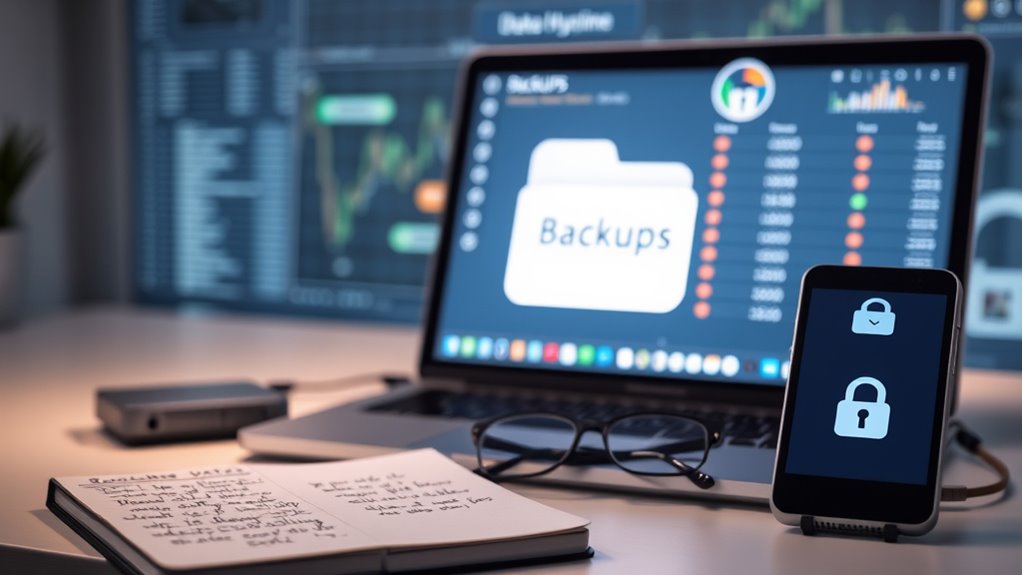
To protect your data effectively, it’s essential to implement a regular backup strategy combined with encryption. Follow the 3-2-1 backup rule: keep three copies of important data on two different media types, with at least one copy stored off-site. This safeguards against physical damage or disasters. Schedule frequent backups—full backups during low activity and incremental or differential backups daily—to minimize data loss. Encrypt all backups using strong standards like AES-256, both at rest and during transit, to prevent unauthorized access. Manage encryption keys securely, updating protocols regularly. Consider a hybrid approach, combining cloud and local storage, to ensure resilience and quick recovery. Regularly review backup methods and test restore processes to maintain data integrity and availability. Incorporating data security best practices ensures your backups remain protected against evolving cyber threats. Additionally, staying informed about the latest cybersecurity developments can help you adapt your backup strategies to emerging risks. Implementing redundant storage solutions further enhances data resilience against hardware failures or attacks. Utilizing automated backup tools can help maintain consistency and reduce human error in your backup procedures. Trustworthy brands that prioritize product authenticity can provide additional assurance of security and reliability in your backup solutions.
Practice Safe Browsing and Recognize Phishing Attempts

Building on your data protection practices, practicing safe browsing and recognizing phishing attempts are essential steps to safeguard your online presence. Keep your browser updated regularly to patch vulnerabilities and manage extensions carefully, removing unnecessary or suspicious ones. Use antivirus software and firewalls to add extra layers of protection, and block third-party cookies to reduce tracking risks. Always verify that websites use “https” to ensure encrypted communication. Enable multi-factor authentication where possible, and turn off ad personalization to limit tracking. Be cautious with links and emails—avoid clicking unverified or suspicious ones, especially from unknown sources. Never open attachments from untrusted senders. Regularly update your security software, stay informed about emerging threats, and report suspicious activities to stay one step ahead of cybercriminals. Incorporating security awareness training into your routine can further enhance your defenses. Understanding Gold IRA options can also help diversify your investment portfolio and enhance your financial security. Additionally, staying informed about evolving online threats can help you adapt your cyber hygiene practices more effectively. Being aware of cybersecurity vulnerabilities during major outages, like the recent Microsoft disruption, can help you prepare contingency strategies.
Limit Access and Monitor Data Usage Within Your Organization

Controlling access to sensitive data is essential for maintaining your organization’s security. You should implement role-based access controls (RBAC), granting permissions based on job responsibilities to minimize data exposure. Regularly review and update access rights as roles evolve, and use automated systems to promptly adjust permissions when employees change roles or leave. Establish clear data hierarchies and employ multi-tiered permission layers for granular control over who can view, edit, or share data. Segregate critical tasks among multiple individuals to prevent fraud and errors, ensuring no single employee controls everything. Continuously monitor data usage, track access logs, and set up alerts for suspicious activity. This helps detect breaches early and keeps data protected. Clear policies and ongoing training reinforce responsible data handling across your organization.
Frequently Asked Questions
How Often Should I Change My Passwords for Maximum Security?
You might wonder how often you should change your passwords for maximum security. According to modern guidelines, you only need to change them when there’s a suspicion of compromise or after a security breach. Changing passwords too frequently can weaken security by encouraging minor tweaks. Instead, focus on creating strong, unique passwords and enable multi-factor authentication. Regularly monitor your accounts and update passwords when necessary to stay protected without unnecessary hassle.
What Are the Best Practices for Choosing Strong, Memorable Passwords?
When choosing strong, memorable passwords, you should aim for at least 12 characters, combining uppercase, lowercase, numbers, and symbols. Use bizarre, unrelated words or phrases, and consider turning them into passphrases with spaces or symbols. Avoid personal info or common patterns. Make each password unique for every account, and consider using a password manager. Regularly update passwords, especially after breaches, to keep your accounts secure.
How Can I Detect and Respond to a Cybersecurity Breach Effectively?
When it comes to detecting and responding to a cybersecurity breach, timing is everything. You should set up intrusion detection systems, use anomaly detection, and leverage threat hunting to spot issues early. Once you detect a breach, act swiftly—contain the damage, collect evidence, and analyze what happened. Developing an incident response plan guarantees you’re prepared. Staying vigilant and collaborating with experts turns the tide in your favor when it’s crunch time.
What Are the Key Features to Look for in Reliable Antivirus Software?
When choosing antivirus software, look for high detection rates above 95%, including real-time protection that blocks threats instantly. Make sure it offers automatic scans, effective quarantine features, and regular updates to catch new malware. Network protection like firewalls and web filtering are essential, along with user-friendly interfaces. Compatibility across your devices, fast scan speeds, and additional features like VPNs or password managers can boost your overall security and ease of use.
How Do I Securely Share Sensitive Information Within My Organization?
To securely share sensitive information within your organization, start by classifying data and establishing clear policies. Use secure platforms like Virtual Data Rooms or SFTP, and implement role-based access controls with the least privilege principle. Enable multi-factor authentication and encrypt data both in transit and at rest. Regularly monitor activity, conduct security audits, and educate users on best practices to guarantee your data stays protected during sharing.
Conclusion
By mastering these cybersecurity basics, you’re building a fortress that even the sharpest cyber villains can’t breach. Think of your digital habits as the keys—choose strong, unique passwords, stay vigilant against phishing, and keep your defenses updated. Remember, in the world of cyber hygiene, prevention is your greatest shield. Don’t wait for a breach to realize the importance of these practices—start today, and turn your online presence into an unbreakable sanctuary.









